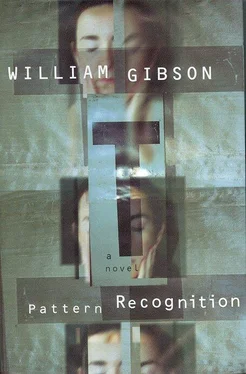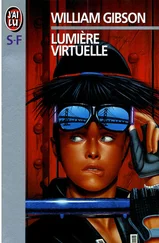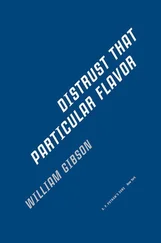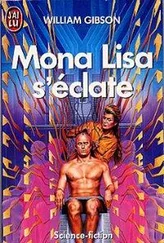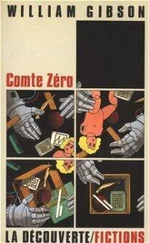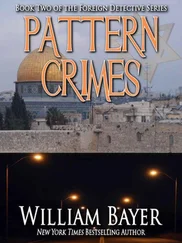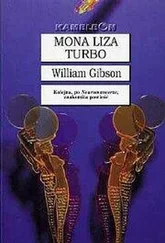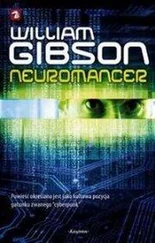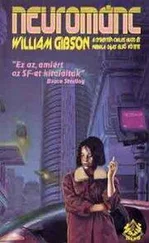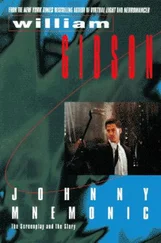The black woman, seeing her notice the little still, had nodded, recognizing a fellow follower, and Cayce had been rescued from inner darkness by this suggestion of just how many people might be following the footage, and just how oddly invisible a phenomenon that was.
There are many more, now, in spite of a general and in her opinion entirely welcome lack of attention from the major media. Whenever the media do try to pick it up, it slides like a lone noodle from their chopsticks. It comes in mothlike, under radar evolved to detect things with massive airframes: a species of ghost, or “black guest” perhaps (as Damien had once explained hackers and their more autonomous creations are known in China).
Shows dealing with lifestyles and popular culture, or with minor mysteries made to seem major, have aired the story, along with dubiously assembled sequences of fragments, but these elicited no viewer response whatever (except on F:F:F, of course, where the assemblages are ripped to shreds amid lengthy and passionate protestations of just how clueless it is to put, say, #23 before #58). Footageheads seem to propagate primarily by word of mouth, or, as with Cayce, by virtue of random exposure, either to a fragment of video or to a single still frame.
Cayce's first footage had been waiting for her as she'd emerged from the flooded all-genders toilet at a NoLiTa gallery party, that previous November. Wondering what she could do to sterilize the soles of her shoes, and reminding herself never to touch them again, she'd noticed two people huddled on either side of a third, a turtlenecked man with a portable DVD player, held before him in the way that crèche figures of the Three Kings hold their gifts.
And passing these three she'd seen a face there, on the screen of his ciborium. She'd stopped without thinking and done that stupid duck dance, trying to better align retina to pixel.
“What is that?” she'd asked. A sideways look from a girl with hooded eyes, a sharp and avian nose, round steel labret stud gleaming from beneath her lower lip. “Footage,” this one had said, and for Cayce it had started there.
She'd left the gallery with the URL for a site that offered all of the footage accumulated to that point.
Ahead, now, in the wet evening light, a twirling blue pulse, as of something meant to warn of whirlpools, vortices…
They are in some larger thoroughfare, multi-lane traffic verging on gridlock. The Blue Ant car slowing, halting, locked in from behind, then edging forward.
As they pass the scene of the accident Cayce sees a bright yellow motorcycle on its side, front forks twisted strangely. The whirling blue light is mounted on a slender mast, rising from a larger, obviously official motorcycle parked nearby, and she sees that this is an emergency medical response vehicle, an entirely mirror-world concept, able to edge through the densest traffic to an accident site.
The bike medic, in a Belstaff jacket with huge reflective stripes, is kneeling above the fallen rider, whose helmet is on the pavement beside him and whose neck is immobilized in a foam collar. The medic is giving the man oxygen with a mask and bottle, and now Cayce realizes she can hear the insistent hooting, from somewhere behind, of a mirror-world ambulance. And for an instant she sees that unconscious, unmarked face, its lower half obscured by the transparent mask, the evening's rain falling on closed eyes. And knows that this stranger may now inhabit the most liminal place of all, poised perhaps on the brink of nonexistence, or about to enter some existence unimagined.
She cannot see what hit him, or what he might have hit. Or else the street itself had risen up, to smite him. It is not only those things we most fear that do that, she reminds herself.
“IT was a match factory,” Stonestreet says, having greeted her and ushered her into two stories of lofted open plan, dark gleaming hardwood stretching to a wall of glass that opens on a full-length balcony. Candlelight. “We're looking for something else.” He's wearing a black cotton dress shirt, its French cuffs unlinked and flapping. The at-home version of that new but slept-in look, she supposes. “It's not Tribeca.”
No, it's not, she thinks, neither in square footage nor in volumes of space.
“Hub's on the deck. Just arrived. Drink?”
“'Hub'?”
“Been in Houston.” Stonestreet winks.
“Bet it would be 'Hube' if they had their druthers.” Hube Bigend. Lombard.
Cayce's dislike of Bigend is indeed personal, albeit secondhand, a friend having been involved with the man in New York, back in, as the kids had recently quit saying, the day. Margot, the friend, from Melbourne, had always referred to him as “a Lombard,” which Cayce had at first thought might be a reference somehow to his Belgian-ness, until learning, upon finally asking, that it was Margot's acronym for “Loads of money but a real dickhead.” As things had progressed between them, mere Lombardhood had scarcely covered it.
Stonestreet, at the wet bar sculpted into a corner of the kitchen's granite island, passes her, at her request, a tall glass of ice and fizzy water, garnished with a twist of lemon.
On the wall to her left is a triptych by a Japanese artist whose name she forgets, three four-by-eight panels of plywood hung side by side. On these have been silk-screened, in layers, logos and big-eyed manga girls, but each successive layer of paint has been sanded to ghostly translucency, varnished, then overlaid with others, which have in turn been sanded, varnished…. The result for Cayce being very soft, deep, almost soothing, but with the uneasy hallucinatory suggestion of panic about to break through.
She turns, and sees Bigend through glass leading to a balcony, hands on the rain-slick railing, his back to her, in some sort of raincoat and what seems to be a cowboy hat.
“HOW do you think we look,” Bigend asks, “to the future?” He looks as though he's somehow, in spite of the evening's cunningly vegan cuisine, been infused with live extract of hot beef. He's florid, glossy, bright-eyed, very likely bushy-tailed as well. The dinner conversation has been mercifully uneventful, with no mention of Dorotea or Blue Ant, and for this Cayce is grateful.
Helena, Stonestreet's wife, has been lecturing them about the uses, even today, in cosmetics, of reprocessed bovine neurological material, having gotten there via a discussion, over her stuffed eggplant, of spongiform encephalopathy as the price of forcing herbivores into an apocalyptically unnatural cannibalism.
Bigend has a way of injecting these questions into conversations that he's grown tired of. Caltrops thrown down on the conversational highway; you can swerve or you can hit them, blow your tires, hope you'll keep going on the rims. He's been doing it through dinner and their pre-dinner drinks, and Cayce assumes he does it because he's the boss, and perhaps because he really does bore easily. It's like watching someone restlessly change channels, no more mercy to it than that.
“They won't think of us,” Cayce says, choosing straight into it. “Any more than we think of the Victorians. I don't mean the icons, but the ordinary actual living souls.”
“I think they'll hate us,” says Helena, only her gorgeous eyes visible now above her nightmares of BSE and a spongiform future. She looks, for just that instant, as though she's still in character as the emotionally conflicted deprogrammer of abductees on Ark/Hive 7's lone season, Cayce having once watched a single episode in order to see a friend's actor boyfriend in a walk-on as a morgue attendant.
“Souls,” repeats Bigend, evidently not having heard Helena, his blue eyes widening for Cayce's benefit. He has less accent of any kind than she can recall having heard before in any speaker of English. It's unnerving. It makes him sound somehow directionless, like a loudspeaker in a departure lounge, though it has nothing to do with volume. “Souls?”
Читать дальше
